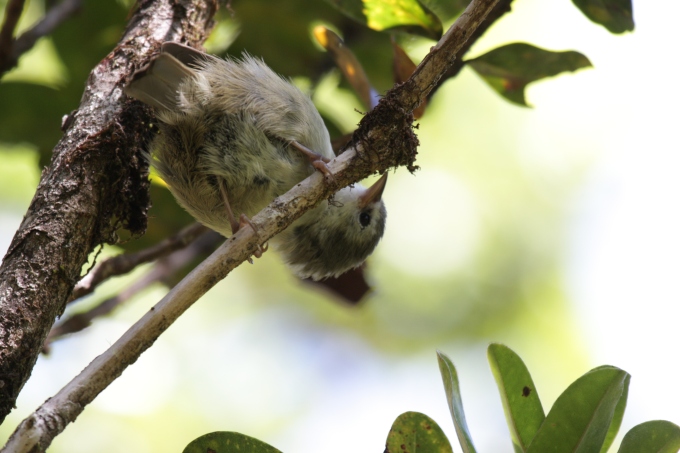Part of my internship includes writing a couple “Great Stories” about my time here on Kauai. This is my first, and I thought it was pretty good material for this blog too. (I know I wrote about Kauai’s birds on my last post… but you can’t have too many bird posts, right?)
Kauai is home to 8 native forest bird species. 6 of them are endemic – found nowhere else in the world outside of this island. 3 of those endemics are endangered, with populations precariously hanging on at less than a thousand individuals. The focus of the Kauai Forest Bird Recovery Project (KFBRP) is to help reverse the declines of these species; to recover them from the brink of extinction. Working for this project is working on the frontlines of a battle against extinction. Many moments have been impossibly hard and impossibly depressing; but when you see the birds – see them foraging, see them breeding, whatever – you can’t help but smile and remember the reason we can’t give up this battle.
The 3 endangered species we focus on here at KFBRP are as follows:
Puaiohi, or Small Kauai Thrush (Myadestes palmeri). Numbering about 500 individuals, the Puaiohi have been listed as endangered since 1967. They are primarily fruit eaters, and nest in pukas (cavities or depressions) on streamside cliff walls.
Akeke’e, or Kauai Akepa (Loxops caeruleirostris). Less than 1000 individuals remain. They have slightly offset bill tips (a “crossbill”) that help them to pry open flower and leaf buds in Ohia canopies in search of insects.
Akikiki, or Kauai Creeper (Oreomystis bairdi). Less than 500 individuals remain. True to their name, these birds “creep” along tree trunks and branches, picking among bark and moss in search of insects.
The Akikiki is my personal favorite. Not just because they’re adorable with their goofy pink feet (all the birds are incredibly cute), but because of their demeanor. Often looking for food below the canopy, I have had the privilege of observing them for hours. They make little hops up and down branches, often flipping over like a gymnast on a bar – their little tails in the air – to reach prime spots on the underside of branches. Quietly as they look, they communicate to each other via airy chirps, as they are often found in small family groups of 2-4 individuals. Watching them, I smile at their acrobatic antics until the inevitable thought hits me: there are less than 500 of these birds left. These could be gone from the wild within 5 to 10 years if we don’t change something. Most people on this island – in the world, really – don’t even know these birds exist at all. They will never be affected by their disappearance and they won’t know the tragic loss that could occur so quickly. This is so sad to me, partly because I think most people would be so charmed by the character of these birds if only they were able to see them.
I love all of what I’m doing here. I love that I get to help spread the word about these birds that are so unique and amazing, in addition to being out in the field directly observing and monitoring them. But there is one moment in particular that will be with me forever, a unique experience that few have had the opportunity to enjoy: I smelled an Akikiki. And it was wonderful. Now don’t get me wrong, I’ve smelled lots of other birds too, but they don’t compare to the Akikiki. When one has a particularly strong sense of smell and just happens to have a bird in hand…. Sometimes it’s irresistible. Most birds have a sort of subtle musty, almost powdery, smell. It’s not a bad smell; it’s rather earthy actually. But the Hawaiian honeycreepers add another level to that musty bird smell, with sweet and flowery undertones (describing bird smell is an art akin to describing the taste of wine). In fact, this strong scent has been so well documented amongst the Hawaiian honeycreepers, that it actually is considered a characteristic of their taxonomic subfamily Drepanidinae, and is (creatively) called the Drepanidine odor. Science says it’s true, I’m not making this up! The Akikiki really takes the cake though. Even after releasing the bird after it has been captured and banded, everything the bird has touched now has that sweet, musty, honeycreeper smell. The scented feathers of this little bird just add to its charm. As if being cute wasn’t enough, it smells good too!
I am distinctly aware of how few people have gotten to experience this smelly little puffball of a bird. Once numbering in the thousands just a few decades ago, the akikiki’s population has plummeted to around 450, mostly due to malaria, predation by non-native predators, and loss of native habitat. And the Akikiki isn’t the only one; most of Hawaii’s honeycreepers are suffering these declines for the same reasons. The field of conservation biology is rough and can be depressing if you’re not careful. But rather than letting despair take over, I use it for motivation. I love these little birds, and I so desperately want them to thrive in the wild. I also want others to experience their charm, and if all goes well, maybe someday that will be possible. Until then, it’s important and exciting for me to tell you about these birds, Drepanidine odor and all. Endangered species are not only the face of conservation, they are also the smell of conservation.
Until next time friends. Go look at a bird. Or smell one, if you happen to have the opportunity.
(P.S. I’d recommend smelling a Wrentit if you want a good, strong representative of the classic, musty bird smell. Just fyi.)
